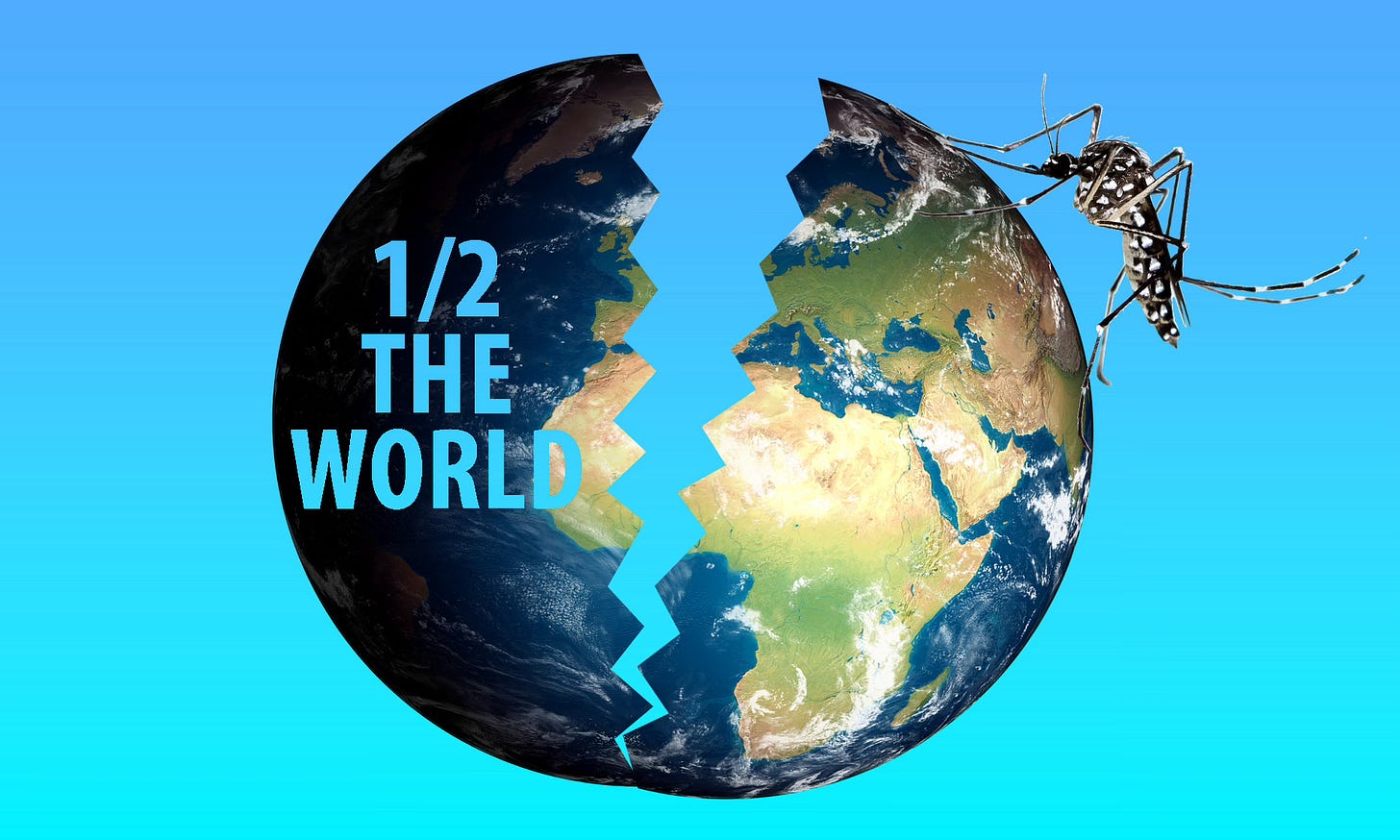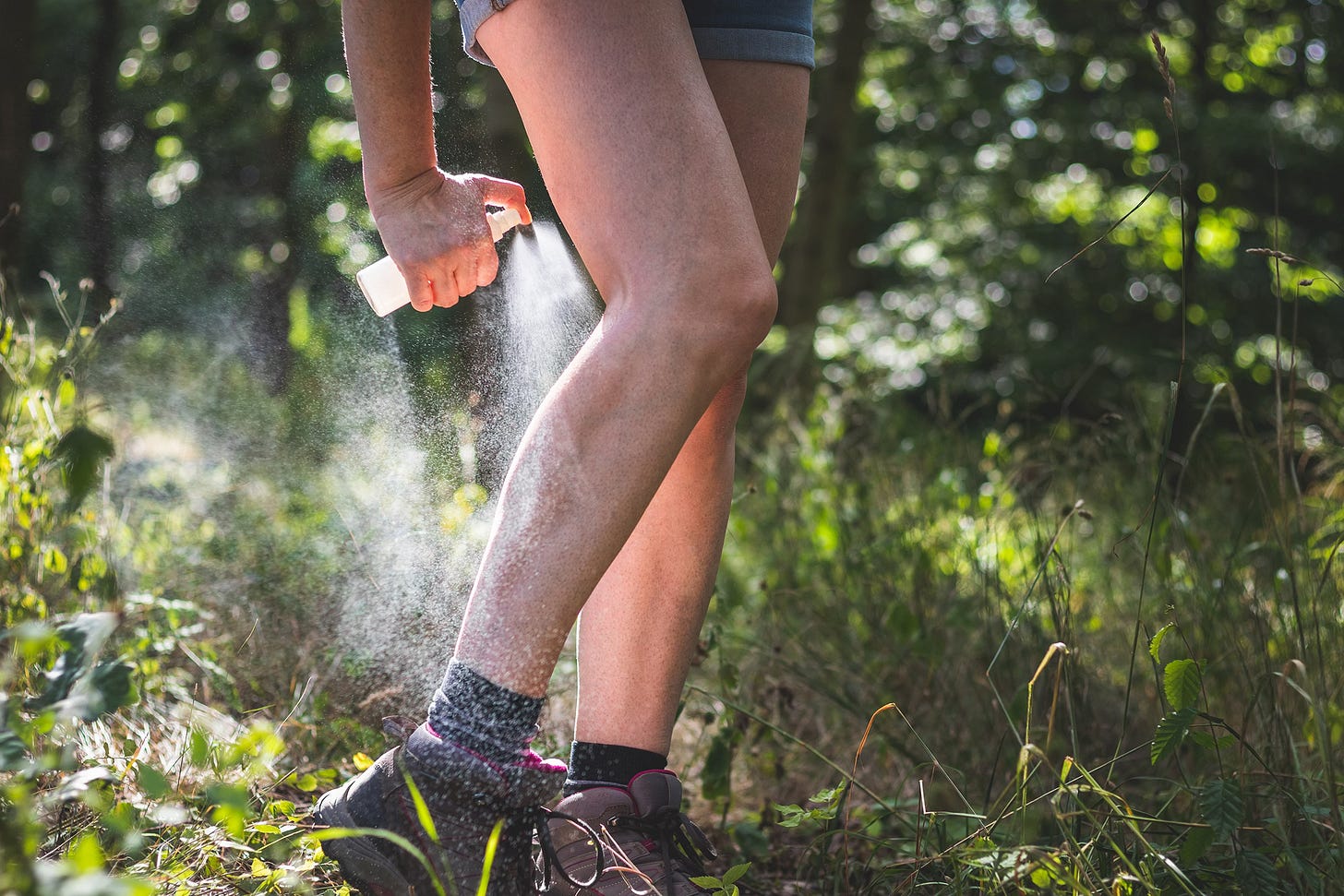The Virulent Viral Sextet: #2 – Dengue
[Globe image thanks to eikira on Pixabay.com]
According to the World Health Organization (WHO), the dengue virus is of the world’s most neglected tropical diseases, and about half of the world's population is now at risk with an estimated 100–400 million infections each year. Most people who get it are either asymptomatic or have mild, easily managed symptoms, so it is often underreported. But if you get a serious or severe case, you’ll know why it’s called “break-bone fever,” because the high fever and pain it can cause in your muscles and joints is so awful it feels like your bones are breaking.
You Really Need to Know About Dengue!
Spread, like malaria, by mosquitoes, dengue is now inflicting grave harm at such an alarming rate that the details in this Substack are extremely pertinent, especially if you’re planning a trip anywhere warm.
That’s because the number of dengue cases in the US has significantly increased from last year, with, according to the CDC’s latest data on September 3, 2024, 4,117 cases identified in U.S. travelers who’d been abroad, and 10 cases from local spread in Florida. Many more individuals may have been exposed but had milder flu-like symptoms and chalked it up to a different virus. Still, the mosquito responsible for dengue is now in several states, including Texas, Florida, and California, so it may only be a matter of time until more local cases begin to appear. In Puerto Rico, especially around San Juan and surrounding municipalities, there has also been a surge in dengue cases, half of them among US travelers.
For now, most cases have been in Asia, but the virus is now creeping into Europe, the Mediterranean, and South America. AWashington Post article on June 30, 2024, entitled “Dengue fever is surging worldwide. A hotter planet will make it worse,” reported that the virus has spread to “roughly 1 in every 800 people on the planet in the past six months alone.” An influx of patients has overwhelmed hospitals from Brazil to Bangladesh, recalling the worst days of the coronavirus pandemic. Puerto Rico declared a public health emergency this spring, with more dengue cases reported in the first five months of 2024 than all of last year.
And as the European Center for Disease Control and Prevention reported in August 2024, “Since the beginning of 2024, over 11 million dengue cases and over 7,000 dengue-related deaths have been reported from 84 countries/territories.”
Why is this happening?
Climate change. A warmer planet with more rain and humidity is just what the female Aedes aegypti, the dengue-carrying mosquito, needs to make it more infectious—higher heat means more eggs, faster growth, and more opportunity for bites. Worse, infected mosquitos stay infected for their entire rotten lifetimes, and an infected human can even transmit the virus to an uninfected mosquito. Worse still, there can be transovarial transmission of dengue--this means the mother mosquito can transmit the virus to her offspring without needing a blood meal. Not good news. That will make it easier to spread.
[Image thanks to WikiImage on Pixabay.com]
So, you don’t want to get bitten! There are 4 varieties of dengue, but infection with one dengue virus strain generally produces lifelong immunity only against that specific virus, with only partial and short-term protection against the other strains. In fact, if you do get infected with multiple types, this increases your risk of severe complications, especially when your antibody titers decrease over time.
Dengue Symptoms and Worst-Case Scenarios
*Although most cases aren't serious, dengue can be fatal and cause internal bleeding, organ failure and death.
*Severe disease develops in about 5% of those bitten, and people at highest risk are those who are very young, elderly, pregnant, or with chronic medical conditions.
*Pregnant patients can theoretically transmit the infection to their fetus (similar to many tick-borne infections) and although the risk is low, a dengue infection can lead to complications in the newborn with pre-term birth, low birthweight, and fetal distress.
*Just like certain tick-borne infections, dengue has also been found to be transmitted via blood products, organ donation and transfusions. Knowing all the potential routes of transmission is important if you get sick.
*There is an incubation period of about 5-7 days before symptoms start, so if you’ve traveled abroad and get sick after your return, this has to be on your radar.
*Early symptoms are non-specific and include:
A high fever (40°C/104°F)
Severe headache with pain behind the eyes
Swollen glands
Muscle aches and joint aches
Intense muscle spasms
Severe bone pain
Gastrointestinal symptoms of nausea, vomiting, and/or abdominal pain,
A macular or maculopapular rash (raised, and blanches with skin pressure)
Low white blood cell counts.
Unfortunately, these symptoms overlap many tick-borne infections like Anaplasma, Ehrlichia, Relapsing fever Borrelia, Babesia, rickettsial infections like Rocky Mountain Spotted Fever (Rickettsia rickettsii), and viral tick-borne infections including Bourbon and Heartland virus. We can even see low white cell counts in the above tick-borne infections (along with low platelet counts, and/or elevated liver functions), and not just viral infections like dengue. The intense muscle spasms and bone pain are one of the clues dengue may be present.
Some of the symptoms are also common in other viral infections, such a measles, influenza, and mosquito-borne diseases such as Zika virus disease, West Nile infection, chikungunya, malaria, and yellow fever. And since some of these infections that can look like dengue are fatal if not caught early, where tests can be negative before antibodies have a chance to form, a high clinical suspicion is required in the right clinical setting. This is why a Medical Detective has to be alert to the different possible diagnoses if you present with any of the dengue symptoms.
Anyone with high fevers, severe headaches and eye pain, severe muscle and joint pain, gastrointestinal symptoms including GI bleeding, and lethargy with a low white cell count during warm weather should be prescribed doxycycline until further testing is done. Antibodies can be negative early on with dengue, just as they are in tick-borne infections. A positive NS1 dengue antibody test means you have been exposed, but a negative test result doesn’t rule it out. There is also the possibility of exposure to other viruses in the same family as dengue (flaviviruses) like Zika virus, West Nile, Yellow fever, or Powassan virus. These can give you a false positive dengue fever result, so make sure you check for these other viral infections if you test positive! Exposure to some of these other flaviviruses like Zika can also increase the risk of complications from dengue if you are exposed, just as prior exposure to another Dengue viral strain can cause severe disease if your antibody levels fall over time (called antibody-dependent enhancement, or ADE). Another reason why you want to limit exposure to ticks and mosquitos!
Warning Signs of Severe Dengue
Unlike other diseases, where a decrease in fever is a sign that someone's getting better, for dengue, this is not the case. That is when you need to be on high clinical alert. This phase of defervescence (lower temperatures) typically lasts for 24 to 48 hours, and according to the WHO, warning signs that indicate progression to severe disease, which may appear after the fever is gone include: pale and cold skin, extreme thirst, severe abdominal pain or tenderness, persistent vomiting with or without blood, bleeding from the nose or gums (which is why it is called hemorrhagic fever), blood in the stool, fatigue with weakness, lethargy or restlessness, and rapid breathing. Usually before this critical phase sets in, there is often a rapid decline in platelet counts, accompanied by increased hematocrit levels. Leukopenia (low white cell counts) may also occur up to 24 hours before the platelet count drops and warning signs emerge.
There can also be a syndrome called “Expanded dengue virus syndrome” which refers to atypical manifestations seen in patients with multisystem involvement (liver, pancreas, gallbladder, kidneys, heart, lung, and central nervous system). This can cause shock, febrile seizures in young children, brain inflammation (encephalitis), aseptic meningitis (inflammation in the covering around the spinal cord and brain), and intracranial bleeding. You will notice that no organ is spared.
Is There a Cure for Dengue? No, There Is Not. What About Treatment?
*There is no cure for dengue. There are limited vaccine options.
*Treatment usually involves rest and painkillers, and acetaminophen (Tylenol) is often used to control pain. Avoid typical pain relievers like NSAIDS (non-steroidal anti-inflammatory drugs), ibuprofen (Motrin), and aspirin as they can increase the risk of bleeding. Those with severe cases need hospitalization.
*One promising treatment may be glutathione, an over-the-counter antioxidant that has been shown to have some positive effects in other viral infections including Covid, the flu, and HIV. (The study on dengue and glutathione was reported in a study published in Biochemical and Biophysical Research Communications back in July 2010.) That’s because glutathione helps to block an inflammatory pathway in the body known as NF Kappa B (the same one we see activated in Lyme disease and Covid). Suffice it to say that a severe inflammatory response can also be seen in cases of severe Covid and was common during the first wave of the virus in 2020 when millions died as well as certain types of cancer and autoimmune disease. Dexamethasone is one of the treatments used for this complication along with other immune suppressants.
*Another promising treatment is a nutritional supplement called pDC Activate, a unique postbiotic, Lactococcus lactis strain Plasma (LC-Plasma), with a novel mechanism of action that stimulates immune function at the cellular level for broad-range immune support. There have been 29 scientific studies validating its safety and efficacy. One of these studies, a 2021 randomized, placebo-controlled, double-blind trial in Malaysia showed a significant reduction in the cumulative number of days of dengue fever-like symptoms, including fever, muscle pain, joint pain and pain behind the eyes, in participants who took LC-Plasma daily for 8 weeks compared to the placebo group (Khor CS, et. al., Lactococcus lactis Strain Plasma Intake Suppresses the Incidence of Dengue Fever-like Symptoms in Healthy Malaysians: A Randomized, Double-Blind, Placebo-Controlled Trial. Nutrients. 2021;13(12):4507).
*Although most severe complications of dengue fever would be due to this hyperinflammatory syndrome, there are no controlled trials on the above treatments to date.
How to Protect Yourself from Dengue
*For now, wear mosquito and tick repellants like picaridin 20%, DEET and/or IR3535 (for pregnant women, it has an amino acid base and safe based on 30+ years of studies in Europe).
*Be as vigilant about skin exposure as you would be for ticks. The mosquitoes that spread dengue are active during daylight hours, so you can lower your risk by covering as much of your body as possible during the day, wearing light-colored clothing, using mosquito nets in tropical countries (they can also be sprayed with insect repellants to increase efficacy), and window screens.
*Since many viral infections have to lower glutathione levels to replicate, increasing inflammation and causing illness, a possible approach to prevention--which I do during times of Covid (but needs to be confirmed in large clinical trials for COVID, the flu, dengue, etc.)--is to address 3 major inflammatory pathways. The first inflammatory pathway is called NFKappa B, and I block it with these over-the-counter supplements:
NAC 600 mg twice a day
Alpha lipoic acid 600 mg twice a day (be careful if you have hypoglycemia)
Glutathione, at a minimum dose of 500 mg twice a day. During viral peak season, I increase my glutathione dosing.
*I also block inflammation by supporting an anti-inflammatory pathway called Nrf2, that simultaneously supports detoxification:
Turmeric (curcumin, 500 mg twice a day)
Broccoli seed extract (sulforaphane glucosinolate 100 mg twice a day)
Resveratrol
Green tea.
*Third, I use low dose melatonin (1-3 mg) which can help inhibit NFKappa B and a third inflammatory pathway, NLRP3 inflammasomes. This pathway is abnormally activated with a dengue virus infection, which is also a fundamental innate immune response to many different viral infections.
*Finally, for those who are at risk for dengue because of travel plans, I would consider adding pDC Activate--Lactococcus lactis strain Plasma (LC-Plasma)--before travel, since it was proven to significantly reduce in dengue fever-like symptoms.
*More information can be found on my website www.cangetbetter.com under the COVID tab, discussing prevention. These should be discussed with your healthcare provider, but none of my patients using these nutraceuticals have died from Covid during the past 4 years, and that was before anti-virals were available.
You will be seeing much more about dengue fever in the news as time goes by. Viral infections are increasing across the globe, in part, as I said, due to climate change. I’ll be writing much more about climate change in the months to come and ways to protect ourselves from some of the health consequences of our changing climate.
For more information on novel solutions for our climate crisis, please see my cli-fi Starseed R/evolution, the Awakening. www.starseed-revolution.com








